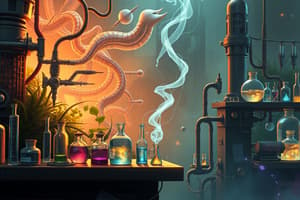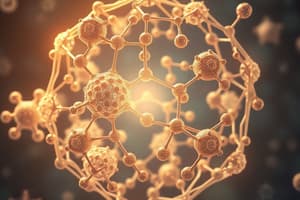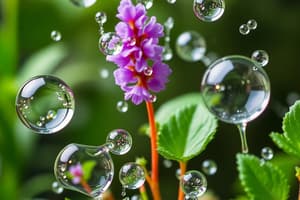Podcast
Questions and Answers
What distinguishes a compound from an element?
What distinguishes a compound from an element?
- A compound consists of two or more types of atoms, while an element consists of only one type. (correct)
- A compound has visible components, while an element does not.
- A compound is a pure substance, while an element is a mixture.
- An element can be broken down into simpler substances, while a compound cannot.
Which of the following is considered a physical change?
Which of the following is considered a physical change?
- Ice melting into water (correct)
- Food rotting
- Burning wood
- Rust forming on iron
In the carbon cycle, which process produces oxygen as a byproduct?
In the carbon cycle, which process produces oxygen as a byproduct?
- Combustion
- Cellular respiration
- Decomposition
- Photosynthesis (correct)
What is the main factor that causes the seasons on Earth?
What is the main factor that causes the seasons on Earth?
Which statement about electric charges is correct?
Which statement about electric charges is correct?
Flashcards
Element
Element
A substance that is made up of only one type of atom, represented by a chemical symbol (e.g., H₂ for hydrogen).
Chemical Change
Chemical Change
The process where atoms combine chemically, forming a new substance with different properties than the original elements. It involves breaking and forming new bonds.
Niche
Niche
The role of a species within an ecosystem, including its food sources, habitat, and interactions with other organisms.
Bioaccumulation
Bioaccumulation
Signup and view all the flashcards
Ohm's Law
Ohm's Law
Signup and view all the flashcards
Study Notes
Chemistry
- Particle Theory: All matter is composed of tiny, constantly moving particles. Particles attract each other and have spaces between them. Increased temperature means faster particle movement.
- Types of Matter:
- Element: A pure substance, like hydrogen (H₂).
- Compound: Two or more different atoms combined, like carbon dioxide (CO₂).
- Solution: A uniform-looking mixture, like coffee.
- Mechanical Mixture: Visible components, like pizza.
- Chemical vs. Physical Changes: Chemical changes involve color change, heat/light production, precipitate formation or gas release. Dissolving is generally a physical change.
- Density: Density equals mass divided by volume. Use the density triangle to rearrange formulas.
- Atomic Structure: Understanding atomic structure (like Bohr diagrams) is important.
Biology
- Habitat vs. Niche:
- Habitat: The place where an organism lives.
- Niche: An organism's role in its ecosystem (what it does).
- Carbon Cycle: Photosynthesis and cellular respiration are key processes.
- Food Webs: Understand trophic levels (producers, primary consumers, etc.).
- Bioaccumulation: Toxins accumulate through food chains, such as pesticides affecting hawks.
Physics
- Electric Charges: Opposite charges attract, and like charges repel.
- Current vs. Static Electricity: Understand their differences and definitions.
- Circuit Diagrams: Know the symbols and how to draw series and parallel circuits.
- Ohm's Law: Relates voltage, current, and resistance.
Astronomy
- Seasons: Earth's tilt causes variations in sunlight distribution throughout the year.
- Pluto's Classification: Understand criteria for classifying planets versus dwarf planets.
- Asterisms vs. Constellations: Asterisms are subsets of constellations, like the Big Dipper.
Studying That Suits You
Use AI to generate personalized quizzes and flashcards to suit your learning preferences.




